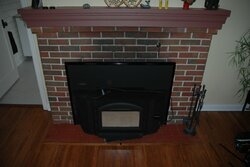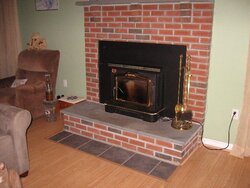Hey all, been getting some great info on hearth construction, so now Im going to pose this question:
In the manual for the 1402, there is no reference to minimum r-value requirements for the hearth, other than mentioning the min dimensions needed, and also outlining how the hearth is to be made with non-combustible materials.
So going with that, I want to confirm: Can any non-combustible material can be used regardless of r-value for the hearth construction?
I had a design of the hearth in mind such that I was thinking of removing the existing red tile (what I can remove around the stove already installed), and then cut a sort of elliptical curve in front to maintain the min. dimensions, removing the hardwood flooring, and then laying down some tile in its stead.
Then a fella at Home Depot suggested that I could make a removable hearth pad, constructed with a backer board and tile on top of that. One which I could have in place for use in the winter, and then take out in the summer.
I kinda liked that idea when he mentioned it. But he did mention that I'd need an inch at least (of mortar? of board? Im not really sure, I didn't clarify this with him) to prevent any cracking of the grout between the tiles from traffic. The traffic would be minimal, by no means regular traffic on the hearth. Would this be the case?
It seems to me that the removable hearth would be less work, which isnt really a deciding factor, I just want to install something that will last!
Any advice/direction would be appreciated! Thanks!!
In the manual for the 1402, there is no reference to minimum r-value requirements for the hearth, other than mentioning the min dimensions needed, and also outlining how the hearth is to be made with non-combustible materials.
So going with that, I want to confirm: Can any non-combustible material can be used regardless of r-value for the hearth construction?
I had a design of the hearth in mind such that I was thinking of removing the existing red tile (what I can remove around the stove already installed), and then cut a sort of elliptical curve in front to maintain the min. dimensions, removing the hardwood flooring, and then laying down some tile in its stead.
Then a fella at Home Depot suggested that I could make a removable hearth pad, constructed with a backer board and tile on top of that. One which I could have in place for use in the winter, and then take out in the summer.
I kinda liked that idea when he mentioned it. But he did mention that I'd need an inch at least (of mortar? of board? Im not really sure, I didn't clarify this with him) to prevent any cracking of the grout between the tiles from traffic. The traffic would be minimal, by no means regular traffic on the hearth. Would this be the case?
It seems to me that the removable hearth would be less work, which isnt really a deciding factor, I just want to install something that will last!
Any advice/direction would be appreciated! Thanks!!



